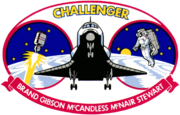STS-41-B
| Mission emblem | |||
|---|---|---|---|

|
|||
| Mission dates | |||
| Mission: | STS-41-B | ||
| COSPAR-ID : | 1984-011A | ||
| Crew: | 5 | ||
| Begin: | February 3, 1984, 13:00:00 UTC | ||
| Starting place: | Kennedy Space Center , LC-39A | ||
| Number of EVA : | 2 | ||
| Landing: | February 11, 1984, 12:15:55 UTC | ||
| Landing place: | Kennedy Space Center, Lane 15 | ||
| Flight duration: | 7d 23h 15m 55s | ||
| Earth orbits: | 128 | ||
| Track height: | 350 km | ||
| Orbit inclination : | 28.5 ° | ||
| Covered track: | 5.2 million km | ||
| Payload: | WESTAR-VI, PALAPA-B2 | ||
| Team photo | |||
 v. l. No. Robert Stewart, Vance Brand, Ronald McNair, Robert Gibson, Bruce McCandless |
|||
| ◄ Before / After ► | |||
|
|||
STS-41-B ( English S pace T ransportation S ystem ) is a mission designation for the US Space Shuttle Challenger ( OV -99) of NASA . The launch took place on February 3, 1984. It was the tenth space shuttle mission and the fourth flight of the space shuttle Challenger.
team
- Vance Brand (3rd space flight), commander
- Robert Gibson (1st spaceflight), pilot
- Bruce McCandless (1st Spaceflight), Mission Specialist
- Ronald McNair (1st Spaceflight), Mission Specialist
- Robert Stewart (1st spaceflight), mission specialist
Mission overview
STS-41-B was the first space shuttle flight to both take off and land at the Kennedy Space Center.
A highlight of the flight was the first free spacecraft operation without a safety line. The astronauts Bruce McCandless and Robert Stewart used Manned Maneuvering Units and moved up to a hundred meters from the shuttle.
The shuttle had the two satellites WESTAR-VI and PALAPA-B2 on board as cargo. However, due to a failure of the Payload Assist Module-D (PAM-D), they entered an orbit that was too low. In the course of the STS-51-A mission , these two satellites were recovered in space and brought back to Earth.
Numbering system
With this mission, a new numbering system for shuttle flights was introduced. The number 4 stood for the US financial year 1984, which ran from October 1983 to September 1984, the 1 for the Kennedy Space Center launch site. The letter B indicated that it was scheduled for the second mission of the year. The first was STS-9 , which was still numbered under the old system.
This new system also avoided giving the number 13 to a shuttle flight. NASA was not officially superstitious, but the only manned flight with that number, Apollo 13 , had almost ended in disaster.
The new system was used until flight STS-51-L , which was planned for fiscal year 1985 but did not take off until January 1986. The space shuttle broke up shortly after take-off, resulting in a break of over two years.
From the next flight, STS-26 , they reverted to numbering.
See also
Web links
- NASA Mission overview (English)
- Video summary with comments of the crew (English)
